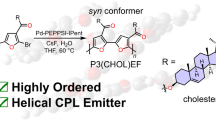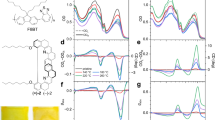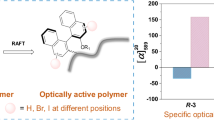Abstract
Three optically active polyesters possessing C2 chiral spirobifluorene moieties in the main chains were prepared and their structural feature was discussed mainly by the UV-vis and CD spectral characteristics. Polycondensation of optically active (R)-(+)-2,2′-dihydroxy-9,9′-spirobifluorene 1 and terephthaloyl dichloride 2a in THF in the presence of triethylamine yielded the corresponding polyester as methanol-insoluble part (3a, 89%, Mw 5400, Mw/Mn 3.5). The polymerizations with 2,6-naphthaloyl dichloride 2b and 4,4′-azodibenzoyl dichloride 2c also afforded polyesters 3b (95%, Mw 20000, Mw/Mn 2.3) and 3c (95%, Mw 6200, Mw/Mn 2.2), respectively. In the solvent-free polymerization, the corresponding polyester 3a was obtained in 40% yield (Mw 16000). In the case of racemic 1rac, similar yield and molecular weight for 3a were achieved. Although no clear glass transition point was observed in all three polymers, these polymers had high thermal decomposition temperature over 480 °C. In the UV-vis and CD spectra of the polymers 3, bisignate Cotton effect was observed in the UV-vis absorption region of optically inactive diacid part of the repeating unit in all three polymers. Further, CD intensity of 3 depended upon temperature: the temperature increase corresponded to the decrease in CD intensity. Both the results obtained and the structure simulation of 3 suggested their helical conformation.
Similar content being viewed by others
Log in or create a free account to read this content
Gain free access to this article, as well as selected content from this journal and more on nature.com
or
References
T. Nakano and Y. Okamoto, Chem. Rev., 101, 4013 (2001).
L. Pu, Chem. Rev., 98, 2405 (1998).
Y. Okamoto, K. Suzuki, K. Ohta, K. Hatada, and H. Yuki, J. Am. Chem. Soc., 101, 4763 (1979).
A. K. M. F. Azam, M. Kamigaito, and Y. Okamoto, Polym. J., 38, 1035 (2006).
A. J. M. Van Beijnen, R. J. M. Nolte, W. Drenth, and A. M. F. Hezemans, Tetrahedron, 32, 2017 (1976).
T. Patten and B. M. Novak, J. Am. Chem. Soc., 113, 5065 (1991).
E. Yashima, K. Maeda, and Y. Okamoto, Nature, 399, 449 (1999).
T. Hasegawa, K. Maeda, H. Ishiguro, and E. Yashima, Polym. J., 38, 912 (2006).
J. C. Nelson, J. G. Saven, J. S. Moore, and P. G. Wolynes, Science, 277, 1793 (1997).
K. Akagi, G. Piao, S. Kaneko, K. Sakamaki, H. Shirakawa, and M. Kyotani, Science, 282, 1683 (1998).
M. Fujiki, J. Am. Chem. Soc., 116, 6017 (1994).
T. Takata, Jasco Report, JPN, 2001.
T. Takata, in “Precision Polymers and Nano-Organized Systems” T. Kunitake, S. Nakahama, S. Takahashi, N. Toshima, Ed., Kodansha, Tokyo, 2000, pp 85–88.
L. A. Howe and G. D. Jaycox, J. Polym. Sci., Part A: Polym. Chem., 36, 2827 (1998).
F. Kondo, D. Takahashi, H. Kimura, and M. Takeishi, Polym. J., 30, 161 (1998).
Q. S. Hu, D. Vitharana, G. Y. Liu, V. Jain, M. W. Wagaman, L. Zhang, T. R. Lee, and L. Pu, Macromolecules, 29, 1082 (1996).
K. Maeyama, K. Ogura, A. Okamoto, K. Ogino, H. Saito, and N. Yonezawa, Polym. J., 37, 736 (2005).
K. Maeyama, S. Maeda, H. Saito, and N. Yonezawa, Polym. J., 39, 342 (2007).
T. Takata, H. Matsuoka, and T. Endo, Chem. Lett., 2091 (1991).
T. Takata, H. Matsuoka, T. Hirasa, J. Matsuo, T. Endo, and Y. Furusho, Kobunshi Ronbunshu, 54, 684 (1997).
T. Takata, Y. Furusho, K. Murakawa, T. Endo, H. Matsuoka, T. Hirasa, J. Matsuo, and M. Sisido, J. Am. Chem. Soc., 120, 4530 (1998).
K. Murakawa, Y. Furusho, and T. Takata, Chem. Lett., 94 (1999).
T. Takata, K. Murakawa, and Y. Furusho, Polym. J., 31, 1051 (1999).
T. Takata, M. Goto, Y. Furusho, and T. Kato, Kobunshi Ronbunshu, 59, 778 (2002).
M. Goto, Y. Furusho, and T. Takata, ITE Letters, 3, 597 (2002).
Y. Ikari, R. Seto, T. Maeda, and T. Takata, Kobunshi Ronbunshu, 63, 512 (2006).
Y. Furusho, T. Maeda, T. Takeuchi, N. Makino, and T. Takata, Chem. Lett., 1020 (2001).
T. Maeda, Y. Furusho, and T. Takata, Chirality, 14, 587 (2002).
T. Maeda, T. Takeuchi, Y. Furusho, and T. Takata, J. Polym. Sci., A: Polym. Chem., 42, 4693 (2004).
A. M. Sargeson, Pure Appl. Chem., 50, 893 (1978).
V. Prelog and D. Bedekovic, Helv. Chem. Acta, 62, 2285 (1979).
D. S. Reddy, C. Shu, and F. Wu, J. Polym. Sci., Part A: Polym. Chem., 40, 262 (2002).
C. Chou, D. S. Reddy, and C. Shu, J. Polym. Sci., Part A: Polym. Chem., 40, 3615 (2002).
S. Wu and C. Shu, J. Polym. Sci., A: Polym. Chem., 41, 1160 (2003).
D. S. Reddy, C. Chou, C. Shu, and G. Lee, Polymer, 44, 557 (2003).
Y. Kim, H. Kim, and S. Kwon, Macromolecules, 38, 7950 (2005).
J. Yan, X. Cheng, Q. Zhou, and J. Pei, Macromolecules, 40, 832 (2007).
F. Toda and K. Tanaka, J. Org. Chem., 53, 3607 (1988).
J. Liu and P. H. Geil, J. Polym. Sci., Part B: Polym. Phys., 35, 1575 (1997).
B. Philip and K. Sreekumar, J. Mater. Sci., 38, 1573 (2003).
Author information
Authors and Affiliations
Corresponding author
Rights and permissions
About this article
Cite this article
Seto, R., Maeda, T., Konishi, Gi. et al. Synthesis and Structure of Optically Active Polyesters Containing C2 Chiral Spirobifluorene Moieties in the Main Chain. Polym J 39, 1351–1359 (2007). https://doi.org/10.1295/polymj.PJ2007026
Received:
Accepted:
Published:
Issue date:
DOI: https://doi.org/10.1295/polymj.PJ2007026



